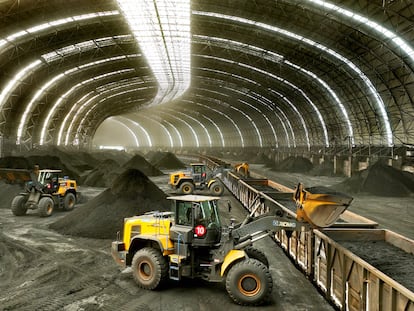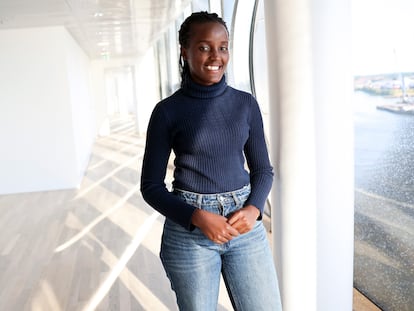A sustainable neighborhood in Buenos Aires province is taking on the climate crisis
The community was created eight years ago on a 173-acre plot belonging to the town of Tornquist. It is supplied with renewable energy and its buildings are bioclimatic. Nowadays, more and more people are being encouraged to live there
The air in the mountainous landscape is pure. But this is not a tagline for an advertisement. The distance from the city is noticeable here. The air is filled with birdsong instead of traffic noise. And the picture-postcard blue sky meets the grasslands to form the horizon. In a world where living in wild places with minimal impact from human activity is no longer a simple task, this neighborhood has become a kind of oasis. Welcome to Prados del Sol, a sustainable community in the town of Tornquist, eight hours from the Argentine capital, Buenos Aires. “The place is intended for people who want to live more sustainably with the planet,” says Maximiliano D’Onofrio, a founding member of the neighborhood, as he walks in front of his bioclimatic house that he made with his partner Gabriela and his 10-year-old son Taiel.
“Locating in this geographical area is key for the future, taking into account projections related to climate change, the predicted rise in sea level, climate, relief, and it is close to some large cities with basic services. This is a sloping terrain, which means that it has energy built-in by using the force of gravity, and if it faces north, we better capture the sun in the summer and winter,” Maximiliano D’Onofrio explains.
This 70-hectare neighborhood is managed by the neighbors themselves and is supplied with renewable energy. It already has more than a dozen of the most varied houses, from earthships (constructions that are made with recyclable materials, such as tires, and with a greenhouse in front that maintains the temperature more naturally), to removable houses and others made with materials such as straw or mud.
Each household seeks to be self-sufficient using organic agriculture and energy efficiency through the use of renewable sources, as well as taking advantage of water and managing their own waste. For this reason, each home has a vegetable garden or fruit trees and its own compost. Some houses were built by the families that live there and others by companies that specialize in bioconstruction to make the most of the climatic conditions in the area.
“The constructions are efficient,” reads the project’s website. “Their building materials have the least impact, since we are seeking to connect with the environment, preserve nature, generate renewable energy, and have our own sovereignty. [The community sits in] a strategic location due to the altitude and the winds, and has high expectations in the face of climate change.” The founding member of Prados del Sol explains that “subdivisions without services” have been encouraged. In other words, living off-grid. And as such, the neighborhood does not have energy systems coming from the cities. “There are 79 lots in a 173-acre neighborhood: there are lots from 16,500 feet to 65,500 feet, designed so that you have almost all the necessary means to live well,” details D’Onofrio.
In search of a more ecological life, the 48-year-old forest ranger decided to start this project. “It has been five years since we moved to this house in a less advanced state than you see now. The raw mud walls allow humidity and temperature to be absorbed,” says D’Onofrio. His home really looks like something out of a National Geographic documentary. It is a concave structure and on entering the first environment guests encounter is a greenhouse. His partner Gabriela is a biologist and conservationist, and she works a lot online. It is cold outside. However, inside we do not feel it.
The heating system the house uses makes it feel like there is some kind of central heating appliance. But there isn’t. It’s just the energy of the sun and the building’s ability to retain the heat. “We have wood-burning accessories. For example, we have adapted an old iron stove that we had, and that is now a wood-burning water heater, meaning that when it is turned on, it now heats the water, the oven, and the heating,” explains D’Onofrio.
Renewable energy
Renewable energies, based on the use of the sun, wind, and water, are resources that can be renewed without limit. Their environmental impact is of lesser magnitude given that in addition to not using finite resources, they do not pollute the environment.
Maximiliano D’Onofrio is aware of this. In the middle of the kitchen, as if he were a philosopher, he asks: “Hey, where does the energy that helps us live come from? How do we get it? Well, we’ve gone a long way towards ‘what do I need to buy?’ when the first question should be ‘where should I stop spending?’ The best energy, the most environmentally friendly, is the one that is not consumed,” he says before explaining the positive effect of the greenhouse he has in front of his house. He remarks that “passive solar energy” helps to cool the home and reduces the need for other sources such as firewood to heat it.
D’Onofrio also has solar panels outside that power a pump that supplies his home with water. “The water climbs a height difference of about 330 feet using only the energy of the sun. So we take the opportunity to pump what we need during the day. We need much less than the pumping capacity, and that is good because we take very good care of the water. We are working for ourselves and without fuel costs to take advantage of the energies that exist naturally and that can be sustained on the planet, and we have water,” he adds.
To start a pump system like this with solar energy, D’Onofrio estimates that you have to invest between $1,500 and $3,000, and take into account that each panel costs about $200.
The family takes the opportunity to pump water on sunny days. “A bathroom set, which is around 53 gallons, provides us with hot water for two whole days for my entire family. And even if we have frost, the water does not cool down,” details D’Onofrio. Also, I can add more tanks to store water. “When there are cloudy days, or at night, I can continue using the water that is stored up the hill,” he explains.
To light and power their home, they use 300-watt solar panels that allow them to have an electrical system “like any city house, with the same devices.” This system also allows them to store excess photovoltaic production in batteries.
A mindful way of life
A few minutes from Maximiliano’s house lives Ignacio Citti, a computer technician who works remotely and who became another of the community’s founding members five years ago. He has also created El Petricor, a farm with “happy chickens” all around his house. It too is supplied with renewable energy and sustainable heating.
Every morning, he and his partner, who is a teacher, gather the first clutch of eggs to start the day. Citti says that belonging to the era in which “everything is learned from YouTube” helped him build much of his house. So, with what they learned online, they built the walls and made adobe bricks. “We have four 320-watt panels. The inverter has two functions: convert direct current into alternating current and charge the two battery banks that we have. The other function is to use battery power when it is cloudy or at night,” he explains.
The panels power the refrigerator, two computers, the lights, a blender, and other appliances. On cloudy days, they do not use the washing machine or the coffee grinder. But, when it’s very sunny, there is plenty of energy. “Summer days are very long and winter days are very short. This is when we have to take care of the electricity supply the most.”
Before arriving in Prados del Sol, Ignacio and his partner lived on the outskirts of Buenos Aires. “We always wanted to escape the city and go live in a rural area. When we saw the project, we loved the idea,” he says. “We bought when all this was wheat, and for many years we lived alone with the field. The change was drastic. It is not for everyone, although everyone should make the effort to try it.”
Tornquist’s experience is not the only one. In different countries, there are small anti-climate change bubbles. These are “energy communities”, that is, groups of people who set up collective organizations to produce, distribute, manage, and consume their own clean energy and live more mindfully with the planet. An alternative that, perhaps, more and more people are considering in the face of the advance of climate change.
Sign up for our weekly newsletter to get more English-language news coverage from EL PAÍS USA Edition
Tu suscripción se está usando en otro dispositivo
¿Quieres añadir otro usuario a tu suscripción?
Si continúas leyendo en este dispositivo, no se podrá leer en el otro.
FlechaTu suscripción se está usando en otro dispositivo y solo puedes acceder a EL PAÍS desde un dispositivo a la vez.
Si quieres compartir tu cuenta, cambia tu suscripción a la modalidad Premium, así podrás añadir otro usuario. Cada uno accederá con su propia cuenta de email, lo que os permitirá personalizar vuestra experiencia en EL PAÍS.
¿Tienes una suscripción de empresa? Accede aquí para contratar más cuentas.
En el caso de no saber quién está usando tu cuenta, te recomendamos cambiar tu contraseña aquí.
Si decides continuar compartiendo tu cuenta, este mensaje se mostrará en tu dispositivo y en el de la otra persona que está usando tu cuenta de forma indefinida, afectando a tu experiencia de lectura. Puedes consultar aquí los términos y condiciones de la suscripción digital.
More information
Archived In
Últimas noticias
Most viewed
- Oona Chaplin: ‘I told James Cameron that I was living in a treehouse and starting a permaculture project with a friend’
- Reinhard Genzel, Nobel laureate in physics: ‘One-minute videos will never give you the truth’
- Sinaloa Cartel war is taking its toll on Los Chapitos
- Why the price of coffee has skyrocketed: from Brazilian plantations to specialty coffee houses
- Silver prices are going crazy: This is what’s fueling the rally










































